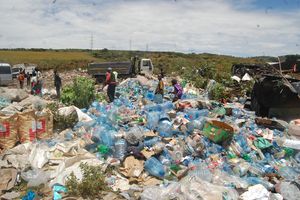How high lead exposure is putting many lives in Kenya at risk

Principal Secretary for Public Health and Professional Standards, Mary Muthoni.
What you need to know:
- PS Mary Muthoni said all Kenyans have a right to access a clean and healthy environment, free from toxic elements.
- Kenyans urged to undertake screening for lead in blood among children, pregnant women and workers in high-risk areas.
Some 132 sites in eight regions are reporting high lead exposure, causing health complications for thousands of Kenyans and even deaths.
This is according to the Principal Secretary for Public Health and Professional Standards, Mary Muthoni.
The 132 sites located in Central, Coast, Eastern, Nairobi, North-Eastern, Nyanza, Rift Valley and Western have been identified as toxic sites.
The PS said the high lead exposure is putting millions of lives at risk. As a result the government will hold polluters accountable for their actions.
"We will no longer tolerate lead exposure that leads to lead poisoning in the country," Ms Muthoni said, adding that the government envisions a future free from lead poisoning.
Speaking during the commemoration of the World Lead Poisoning Awareness Week, Ms Muthoni further stated that all Kenyans have a constitutional right to access a clean and healthy environment, free from toxic elements.
Ms Muthoni said Uasin Gishu, Naivasha in Nakuru County, Gikomba and Dandora dumpsite in Nairobi County, Kisumu, Nyahururu in Nyandarua County, Kajiado, and Changamwe in Mombasa are emerging as key concern zones.
These locations are face increasing challenges related to pollution, waste management, and other environmental hazards, raising urgent calls for action to mitigate the potential impact on the health and well-being of local communities.
The PS also urged Kenyans to undertake screening for lead in blood among children, pregnant women, workers in high-risk areas and communities residing in hotspot areas.
“As the government, we are resource-constrained, and we therefore appeal to our development partners in health to provide the requisite diagnostic infrastructure. This will facilitate screening and sentinel surveillance of lead poisoning, especially in hotspot areas across the country,” Ms Muthoni said.
According to the Ministry of Health, the government has set the lowest allowable limit for lead in paint – 90 parts per million – one of the most stringent globally, and play a pivotal role in the harmonization of paint standards in East Africa.
As a signatory of the Dakar 2002 Pact, Kenya successfully eliminated lead from petrol by December 2005.
“Our efforts also extend to lead-acid battery recycling, with comprehensive guidelines developed by Nema for managing hazardous waste like lead and mineral resources developed guidelines for e-waste management in the country,” Ms Muthoni said, adding that Kenya must now establish clear guidelines and protocols for blood lead level assessments, supported by the necessary diagnostic infrastructure.
“Our partnership with Momentum Multi-Country Global Leadership (MCGL) is key to advancing this agenda. Together, we aim to strengthen multi-sectoral coordination, raise public awareness, monitor environmental lead levels and blood lead levels, and support regulatory enforcement,” the PS said.
Ms Muthoni said that Kenya’s vision of being lead-free is bold yet achievable.
“It envisions a future where our children can learn, play, and grow in a safe environment, where expectant mothers are not at risk of miscarriage due to lead exposure, and where everyone is aware of the dangers of lead. Strong law enforcement and compliance will be vital in realizing this vision,” Ms Muthoni told delegates, while maintaining that Kenya deserves nothing less.
Griffins Ochieng, the Executive Director, the Centre for Environment Justice and Development (CEJAD) pointed out that exposure to even small amounts of lead can reduce a child’s intelligence and academic performance, as well as increased violent behaviour that may lead to conduct disorder, juvenile delinquency, drug use and even incarceration.
“This can occur even if there are no obvious or clinical signs of lead poisoning. The damage is lifelong and irreversible, therefore, high levels of lead in paint are a cause for serious concern,” Mr Ochieng said.
He termed lead poisoning is a tragedy for the country, as children exposed to lead affect the country’s overall potential average intelligence and potential lifelong earnings.
“In 2016, we conducted a study which tested a total of 51 solvent-based paints for home use. A total of 21 paint brands were represented in the samples that were collected and the paints were manufactured in Kenya. 19 out of 21 brands tested (90 per cent of paint brands) had at least one paint colour with high levels of lead that exceed 90 parts per million (ppm) – the strictest international regulatory standard for lead in paint. 15 out of 21 brands tested (71 per cent of paint brands) had at least one paint with more than 10,000 ppm lead,” Mr Ochieng said.
Mr Ochieng also said they had proposed that the Kenya Bureau of Standards gazettes and enact the paint, varnishes and related products standards.
“We are glad it was done in 2018. It put control on the manufacture, import, export, distribution, sale and use of paints that contain total lead concentrations exceeding 90 parts per million, the most restrictive standard in the world,” he said.
“Since Kenya has an existing regulation on lead in paint, Kenya should submit a lead chromate notification to the Rotterdam Convention (RC) Secretariat indicating that the use of lead compounds, such as lead chromates in paint has been severely restricted through the 90 ppm limit threshold set for lead in paint. Listing of lead chromate under RC will assist the authorities in controlling the entry of lead chromates and paint products containing them into the country,” Mr Ochieng said.
Two weeks ago, the Cabinet Secretary for Environment, Climate Change and Forestry, Aden Duale, held a consultative meeting with manufacturers in the country to discuss the use of Extended Producer Responsibility (EPR).
During this meeting, it was revealed that the National Environment Monitoring Agency (Nema) had identified the five biggest polluters of Nairobi River.
“The biggest polluters at number one are manufacturers – factories and industries – which don’t have an effluent treatment plant (ETP),” Duale said.
The second biggest polluters of Nairobi River are the two major water and sewerage companies, while the third biggest polluter is the dumping of garbage by those who transport waste on behalf of the Nairobi City Council, as well as those who carry garbage from residential estates in the capital and dump it in the river.
“Section 13 (1) of the Act states that “Every producer shall bear extended producer responsibility obligations to reduce pollution and environmental impacts of the products they introduce into the Kenyan market and waste arising therefrom. Therefore, today, we called you here to remind you of your obligation to take responsibility for the environmental impacts of your product. If you are in the packaging industry, you must take responsibility for your packaging material,” Duale said.
Interestingly, Kenya has already made strides in addressing lead exposure through several initiatives.





